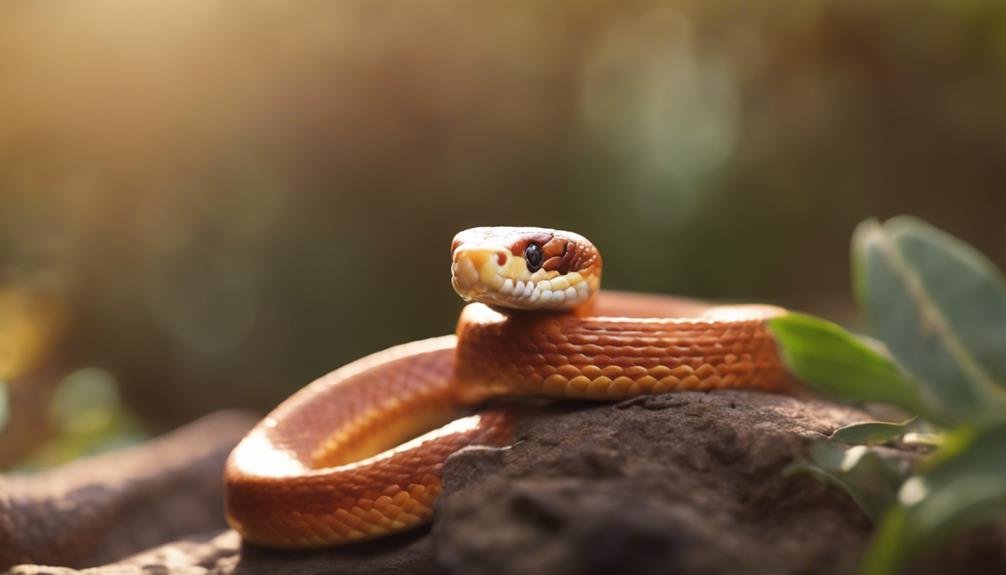As you start on the journey of breeding corn snakes, it’s essential to understand that timing is everything. These alluring reptiles align their breeding cycle with the spring’s warmer temperatures and longer days. By manipulating their environment to mimic these seasonal changes, you can encourage them to breed, but there’s more to it than just adjusting the thermostat. Ensuring your snakes are healthy and ready for the breeding season requires careful planning and preparation. So, if you’re curious about how to create the perfect conditions for breeding corn snakes and what steps to take next, you’re in the right place to uncover the intricacies of this fascinating process.
Key Takeaways
- Corn snakes typically breed in the spring, responding to changes in temperature and day length.
- Breeding can be triggered through environmental manipulation, simulating natural seasonal changes.
- The winter cooling process, lasting 12-16 weeks, prepares corn snakes for breeding by mimicking their natural cycle.
- After the cooling period, temperatures are gradually increased to stimulate reproductive behaviors and signal the start of the breeding season.
- Female corn snakes lay eggs 5-6 weeks after mating, requiring a safe and comfortable environment for egg-laying.
Understanding Corn Snake Breeding
To comprehend corn snake breeding, it’s vital to acknowledge that these reptiles typically enter their breeding phase in spring, driven by the changing seasons. The cycle is deeply ingrained in their biology, responding to the increase in temperature and day length. This predictable pattern is key if you’re looking to breed corn snakes successfully.
After the mating process, which can be encouraged through environmental manipulation such as cooling off adults over the winter, the focus shifts to the female corn snake. She plays a pivotal role in the next stage of breeding: laying eggs. Usually, about 5-6 weeks after a successful mating, you’ll find her ready to lay her eggs. This period is crucial for both the snake and the breeder. It’s a time when the female needs a safe, comfortable environment to lay her eggs, ensuring the next generation of corn snakes.
Understanding this timeline and the needs of the female corn snake during the egg-laying phase is essential. It’s not just about getting to the point of laying eggs but ensuring the conditions are right for the female to do so successfully, marking a significant milestone in the breeding cycle.
Prebreeding Conditions
Before breeding your corn snakes, it’s important to make sure they’re in peak health to prevent any complications during the process. Both male and female snakes need to be robust and healthy for breeding to be successful. It’s essential to put some weight on them before they go into hibernation, as this extra reserve will support their breeding process. However, don’t just focus on fattening them up. You also need to guarantee their digestive tracts are empty before the cooling period begins to avoid any potential issues.
To prepare your snakes for the breeding season, gradually decrease their enclosure temperatures. This slow decrease is crucial to acclimate your snakes to the cooler conditions without shocking their systems. Remember, both the male and female need this adjustment period to ensure they’re in the best possible condition for breeding. By following these prebreeding conditions, you’re setting the stage for a successful breeding season, helping to ensure the health and safety of your snakes throughout the process.
Winter Cooling Process
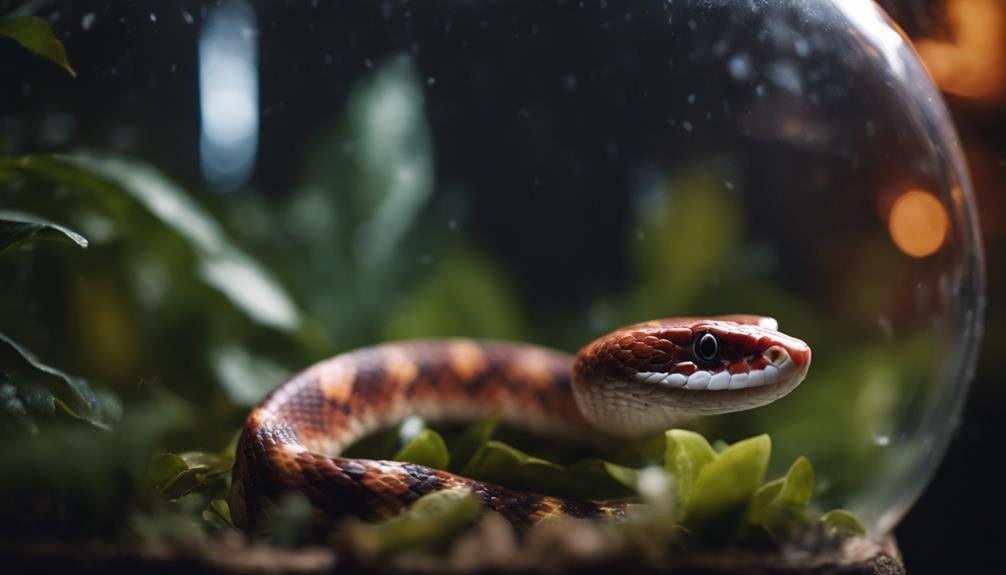

After ensuring your corn snakes are in peak condition for breeding, the next step involves guiding them through the winter cooling process. This critical phase mimics their natural environment’s breeding cycle, preparing them physically for reproduction. The winter cooling period typically spans 12-16 weeks, an essential timeframe that shouldn’t be rushed or extended beyond necessity.
During this cooling period, you’ll gradually reduce the temperature in their enclosure to a range of 10-15°C. It’s important to monitor both temperature and humidity closely, ensuring your snakes remain comfortable and stress-free. Despite the lower temperatures, hydration remains key, so you must provide water continuously to support their health through this phase.
The winter cooling process demands patience and attention to detail. You can’t simply drop the temperature overnight; it’s a gradual process that simulates the natural decrease in temperature they’d experience in the wild. By closely mimicking these conditions, you’re setting the stage for a successful breeding season. Remember, the aim is to recreate a natural, cyclic environment that encourages your corn snakes to enter a state conducive to breeding, ensuring they’re ready for the next step in their reproductive cycle.
Warming Up for Breeding
Once your corn snakes have completed the winter cooling period, you’ll need to gradually increase the enclosure’s temperature to stimulate their reproductive behaviors. This step, known as warming up, is critical after the brumation period. It’s important after the brumation period. This process is designed to mimic the natural increase in temperatures that signals the coming of spring in the wild, telling your snakes it’s time to wake up and get ready for breeding season.
To properly warm them up, you’ll start by slowly adjusting their environment. Sudden temperature changes can stress your corn snakes, potentially harming their health and affecting their willingness to breed. Hence, it’s crucial to incrementally raise the temperature over a few weeks. This gradual approach helps simulate the natural progression of seasons, providing the temperature cues your snakes need to transition out of brumation and into a more active, breeding-ready state.
Introducing Mating Pairs
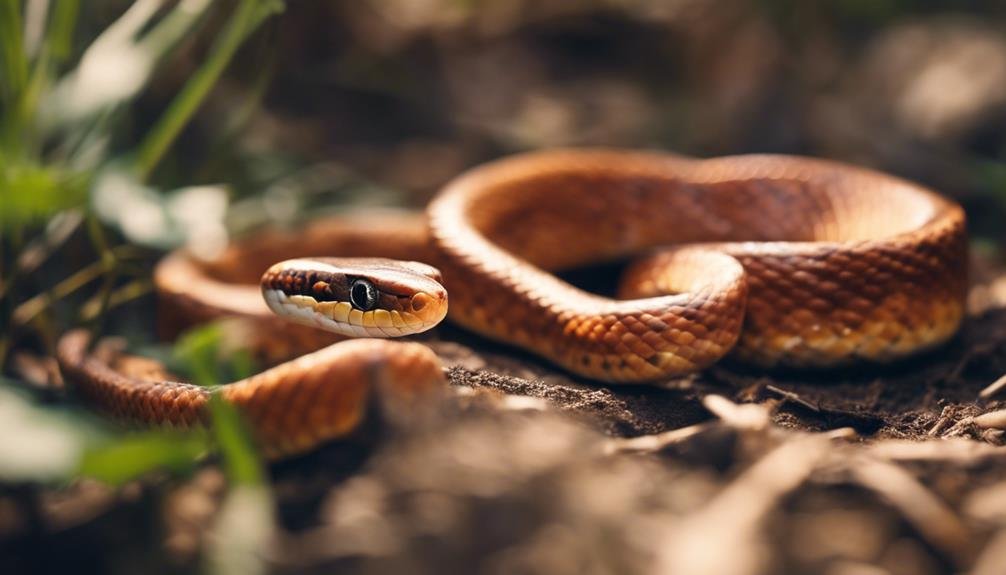

To successfully initiate the breeding process, you’ll need to carefully introduce male and female corn snakes to each other following the brumation period. This delicate period is pivotal as it sets the stage for the mating ritual. You’ll notice the male showing a keen interest in females that are ready to breed. This behavior is your green light to proceed but observe carefully to make sure both snakes are comfortable and receptive to each other.
Here are a few steps to guide you through the introduction:
- Ensure both snakes have fully recovered from brumation and are displaying healthy behaviors, indicating they’re ready to mate.
- Introduce the male to the female’s enclosure to prevent any territorial aggression that might occur if roles are reversed.
- Monitor their interaction closely for signs of interest or distress. A successful pairing will see the male pursuing the female gently.
- Look for the locked position, where they’ll remain for 10-20 minutes, indicating successful mating. It’s crucial to provide the male with rest periods, ideally allowing 3-5 mating sessions per female to maximize fertility chances.
Signs of Successful Mating
Identifying the signs of successful mating in corn snakes is essential for breeders aiming to guarantee a productive breeding season. When male corn snakes exhibit increased activity and a heightened interest in females, you’re on the right track. Spotting a locked mating position between the male and female corn snakes is a clear indicator of successful mating. It’s also advantageous to know that multiple mating sessions can greatly enhance the chances of fertilization success.
After these encounters, you’ll notice a shift in the female corn snakes’ behaviors, which signals successful mating. They may become restless or start showing early signs of nesting preparation. Although discussing egg laying is for later, recognizing these initial changes in behavior is important. Additionally, a post-mating behavior change, such as a reduced appetite or an increased tendency to bask, can further confirm successful mating.
Egg Laying Preparation
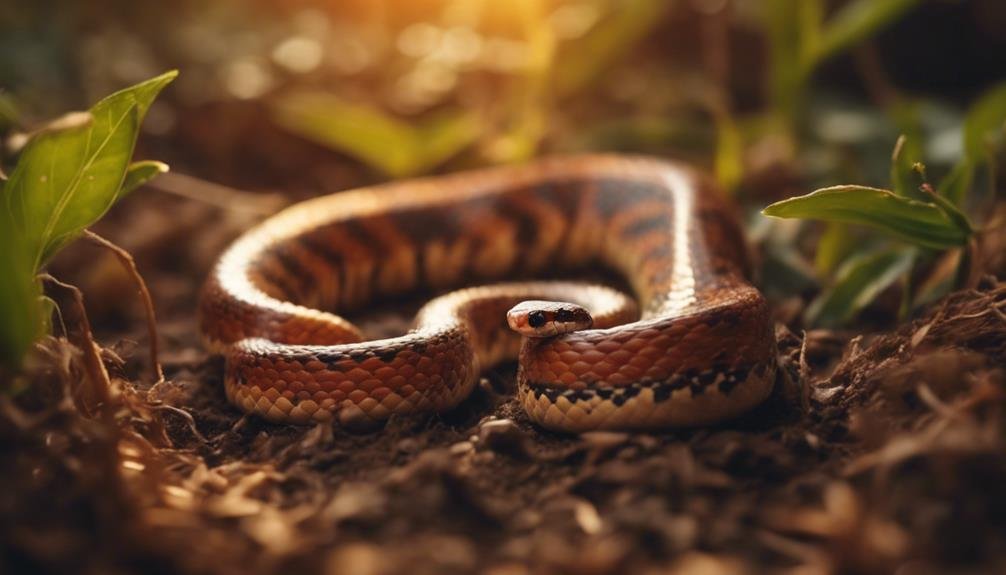

Preparing for egg laying is an important phase in the breeding cycle of corn snakes, requiring careful observation and specific environmental adjustments to support the female. As the time approaches for your corn snake to lay her eggs, you’ll notice several changes indicating she’s ready. The pre-lay shed, occurring 10-14 days before the eggs are laid, marks the beginning of this essential period. Here are essential steps to make sure she has everything she needs for a successful egg-laying process:
- Monitor for the pre-lay shed: This signals that egg-laying is imminent. Keep an eye out for this as it’s your cue to start preparations.
- Provide a lay box with damp sphagnum moss: This creates an ideal environment for her to lay her eggs. The moisture in the moss is crucial for the egg-laying process.
- Keep the moss moist: Regularly check the moisture level of the moss to make sure it’s adequately damp, facilitating the laying of eggs.
- Watch for changes in eating habits: Females may reduce or stop eating as the enlarging eggs take up more space, making it uncomfortable to feed.
Closely monitoring these aspects will help you provide the best care for your corn snake during this time.
Creating Ideal Egg-Laying Conditions
To guarantee your corn snake successfully lays her eggs, you’ll need to focus on maintaining the ideal temperature range and humidity levels.
Preparing the nest box correctly is also essential; it provides a secure and comfortable environment for egg deposition.
Optimal Temperature Range
For successful corn snake breeding, you must maintain the temperature between 75-85°F to create the ideal conditions for egg-laying. This best temperature range is important for stimulating the breeding behavior of corn snakes.
Here are some key facts to remember:
- Corn snakes need consistent temperatures within this range to trigger their breeding and egg production.
- Proper temperature levels are essential for successful mating, egg laying, and the health of hatchlings.
- Temperature fluctuations outside this range can disrupt the breeding cycle and affect reproductive success.
- A stable and controlled temperature environment is critical for encouraging corn snakes to breed and lay eggs.
Humidity Levels Maintenance
Maintaining humidity levels around 70-80% is essential for creating the ideal egg-laying conditions for corn snakes. Proper humidity guarantees the eggs don’t dry out during incubation, which is vital for their development. Using a reliable hygrometer to monitor these levels allows you to adjust as needed, making sure the environment remains consistent. Remember, inadequate humidity can lead to egg deformities or failure to hatch, underscoring the importance of maintaining these levels meticulously.
| Requirement | Strategy |
|---|---|
| Monitor Humidity Levels | Use a reliable hygrometer |
| Adjust Humidity | As needed to maintain 70-80% |
| Prevent Issues | Avoid drying out and deformities |
Nest Box Preparation
Preparing your nest box with damp sphagnum moss is essential for creating the perfect egg-laying environment for corn snakes. This setup mimics their natural habitat, encouraging a stress-free egg-laying process. Here are key steps to guarantee the ideal conditions:
- Maintain the moss’s moisture: It’s vital to keep the sphagnum moss damp but not waterlogged to support egg laying.
- Choose a secure location: Place the nest box in a quiet, sheltered area of the enclosure.
- Monitor the female closely: Watch for any signs of distress or complications during egg laying.
- Avoid disturbing the snake: Minimize stress by not interfering with the female while she’s laying her eggs.
Incubating Corn Snake Eggs
After ensuring your corn snake has laid her eggs under ideal conditions, your focus must shift to incubating them correctly.
You’ll need to maintain the temperature between 76-86°F and keep humidity levels between 50-70% for the eggs to hatch successfully.
It’s also essential to regularly check the eggs for any signs of mold or fungus, as these can jeopardize the health of the developing embryos.
Egg Incubation Temperature
To guarantee successful hatching, you should incubate corn snake eggs at temperatures between 76-86°F. This egg incubation temperature is essential for the healthy development of your corn snake embryos. Utilizing vermiculite or perlite mixed with water as a substrate can help maintain the necessary humidity levels without much hassle.
Here are some essential tips to remember:
- Higher temperatures within this range can lead to faster incubation times.
- Mix vermiculite or perlite with water to make sure the substrate is moist, aiding in humidity control.
- Bury the eggs so that about half to one-third of each egg is visible, preventing suffocation.
- Avoid turning the eggs once they’re set to prevent harming the developing embryos.
Humidity Levels Management
Maintaining humidity levels between 70-80% is crucial when incubating corn snake eggs, as it greatly influences their health and development. You’ve got to monitor this range to prevent the eggs from drying out or getting too moist.
Low humidity can dehydrate the embryos, leading to their death, while high humidity might cause mold to grow, jeopardizing the eggs’ viability. To manage this delicate balance, you’ll need a reliable hygrometer. This tool is your best friend in overseeing the humidity levels within the incubator, enabling you to adjust conditions as necessary.
Do corn snakes breed in specific geographic locations?
Yes, corn snakes breed in specific geographic locations where corn snakes are found. They are primarily found in the southeastern United States, where they prefer the warm and humid climate. These snakes are commonly found in areas with abundant vegetation and ample food sources, such as rodents.
Post-Hatching Care
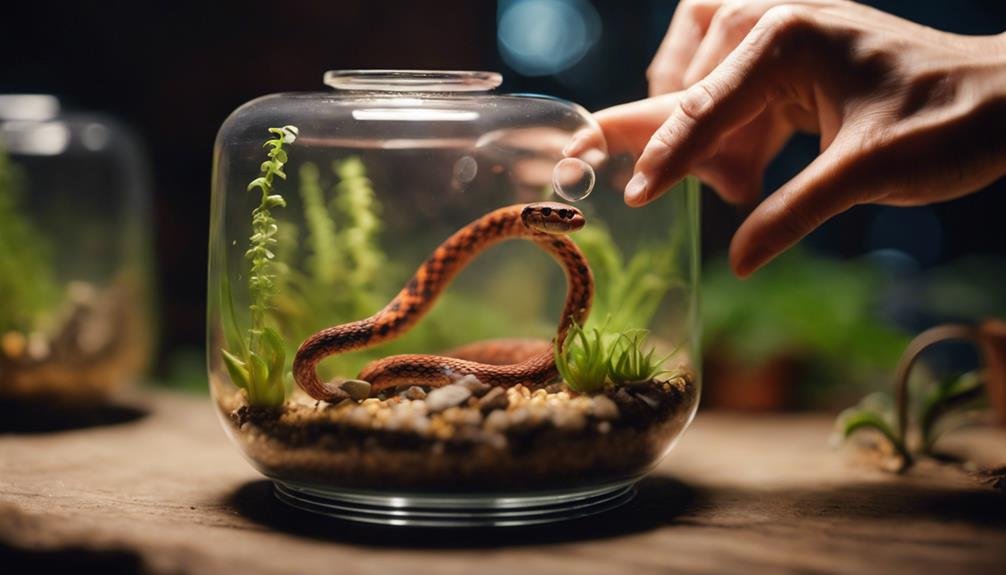

Once your corn snake eggs hatch, it’s vital to provide the proper care for these younglings to guarantee their healthy development. Post-hatching care is critical to make certain your hatchlings grow up healthy and strong. To achieve this, you’ll need to focus on several key aspects of their care from the beginning.
- Provide an appropriate enclosure size and maintain a temperature gradient: It’s important to offer a comfortable living space with a temperature gradient to allow the hatchlings to thermoregulate effectively.
- Offer small prey items: Feeding your young corn snakes suitably sized prey, like pinky mice, is necessary for their nutrition and growth at this early stage.
- Ensure constant access to clean water: Keeping them hydrated is a priority. Make sure they’ve access to fresh, clean water at all times to prevent dehydration.
- Monitor for signs of illness or stress: Keep a close eye on your hatchlings for any unusual behavior or signs of stress and illness, and handle them gently and sparingly to minimize stress.
Conclusion
To sum up, breeding corn snakes successfully hinges on mimicking their natural cycles. Start by ensuring your snakes are healthy, then gradually cool their environment to simulate winter.
Once warmed up, introduce the mating pairs. After mating, focus on providing the perfect conditions for your female to lay her eggs.
Incubating the eggs properly is essential, followed by attentive post-hatching care. By following these steps closely, you’ll optimize the chances of a successful breeding season and healthy offspring.

